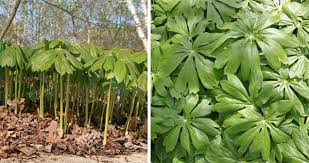
Podophyllum
Latin name: Podophyllum peltatum
Short name: Podoph
Common name: May Apple | American Mandrake | Wild Lemon | Duck’s Foot | Ground Lemon
Primary miasm: Sycotic Secondary miasm(s): Psoric
Kingdom: Plants
Family: Berberidaceae
- Symptomatology
- Remedy Information
- Differentiation & Application
A native North American herbaceous plant with umbrella-like leaves and a yellowish fruit; the rhizome is toxic and highly purgative, rich in podophyllin (a powerful cathartic resin).
Traditionally used by Native Americans as a laxative and emetic; in allopathic medicine, its resin has been used as an anthelmintic and to treat warts and skin cancers.
First proved by Dr. Williamson and detailed in Hering’s Guiding Symptoms and Allen’s Encyclopaedia
- Liver and gall-bladder – biliary dysfunction, congestion, jaundice
- Gastrointestinal tract – explosive diarrhoea, gurgling, prolapse
- Abdomen and rectum – rumbling, distension, colic
- Right ovary and female pelvis – ovarian pain, prolapse
- Teeth and head – headaches alternating with diarrhoea
- Nervous system – dullness, confusion, restlessness in fever
- Lying on the abdomen
- Bending forward
- Passing stool or flatus
- Warmth applied to abdomen
- Rest during diarrhoeic episodes
- Being fanned (in some febrile states)
- Early morning (especially 4–5 a.m.)
- Dentition (in children)
- Hot weather or summer
- Eating or drinking (especially fruit, milk, or sour foods)
- Motion (during diarrhoea)
- During pregnancy or after delivery
- Mercurius solubilis – Also has diarrhoea with tenesmus and mucus, but more offensive, painful, and with salivation
- Aloe socotrina – Diarrhoea with involuntary stool, worse in the morning, but more rectal fullness and urgency
- Chamomilla – Diarrhoea in irritable children during dentition; Cham is more emotional and hot-headed
- Colocynthis – Colic relieved by pressure, but more cramping and angry disposition
- Ipecacuanha – Nausea and vomiting with clean tongue, but less hepatic involvement
- Complementary: Mercurius dulcis, Nux vomica
- Antidotes: Camphora, Nux vomica
- Follows well: Chamomilla, Belladonna
- Precedes well: Sulphur, Lycopodium
Podophyllum is the archetype of violent, draining elimination—its essence lies in purging, emptiness, and collapse. A remedy of explosive diarrhoea, liver congestion, and rectal or uterine prolapse, it is suited to patients who become weak and dazed after discharge. Often needed in children during teething or acute summer diarrhoeas, as well as in adults with hepatic or gastrointestinal pathology. The keynote is the painless yet profuse discharge, coupled with right-sided abdominal complaints and marked exhaustion.
- Excellent in infantile diarrhoea during summer
- Remedy of choice in painless, profuse morning diarrhoea
- Use in post-partum prolapse of uterus or rectum
- Strong indication in right-sided ovarian pain with loose stools
- Effective in gastroenteritis with jaundiced appearance
Mind
- Laughs involuntarily during fever
- Dullness, dazed, stupefied
- Confusion with diarrhoea
Abdomen
- Rumbling, gurgling before stool
- Pain, right-sided, dragging
- Looseness, empty sensation
Rectum
- Diarrhoea, painless, profuse
- Prolapse, during stool
- Offensive, cadaverous stool
Female
- Prolapse, uterus, after delivery
- Ovarian pain, right
- Leucorrhoea profuse, yellow
Generalities
- Weakness after stool
- Morning aggravation
- Summer diarrhoea
C. Hering – Guiding Symptoms: Provided exhaustive notes on diarrhoea, liver, and female symptoms
T.F. Allen – Encyclopaedia of Pure Materia Medica: Source of early provings and toxicological data
William Boericke – Pocket Manual: Gave concise clinical indications and organ affinity
John Henry Clarke – Dictionary of Practical Materia Medica: Described alternation of mental and abdominal symptoms
Samuel Hahnemann – Chronic Diseases (as referenced by followers): Commentary on its liver action and psoric relationship
